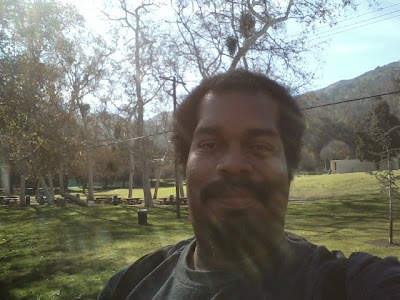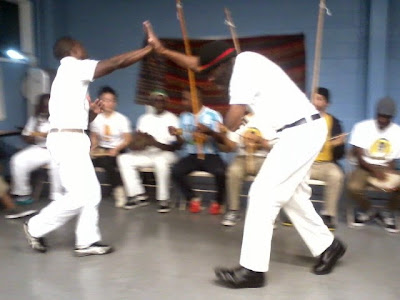WASSUP FAMILY!!!
Well, my SATURDAY was spectacular, but My SUNDAY, well, it was simply AMAZING.
Since Charles wasn't having Capoeira class at Griffith Park that day, I went up to the other side of Griffith Park by the L.A. Zoo, and worked out on my own a litle bit.
After that, I went back to Downtown L.A. and chilled, ate lunch, and got ready to go to inglewood for the annual NEW YEAR CAPOEIRA ANGOLA OPEN RODA hosted by CENTRO ESPORTIVO DE CAPOEIRA ANGOLA LA!
But first, a little background. The Centro Esportivo de capoeira Angola LA is the Los Angeles Branch of the Centro Esportivo de Capoeira Angola in New York, the school headed by the legendary Mestre Joao Grande.
João Oliveira dos Santos, better known as Mestre João Grande, is a Grão-Mestre (Great Master) of the Afro-Brazilian martial art of capoeira angola who has contributed to the spread of this art throughout the world. He was a student of the "father of Angola", Mestre Pastinha, and has an academy in New York City.
Mestre João Grande was born January 15, 1933, in the village of Itagi in the south of the Brazilian state of Bahia. As a child he worked alongside his family in the fields. At the age of 10 he saw "corta capim" for the first time.
In case you're wondering, this is a corta capim:
Fascinated, he asked what it was called and was told that it was "the Dance of the Nagos" — a dance of the African descendants in the city of Salvador. The Yoruba of Southwest Nigeria had a major cultural influence in Salvador, which was considered the Black Rome of Brazil. But the dance was actually of Central African origin— it was Capoeira. João didn't learn the correct name of the movement until many years later, but it changed his life forever. At the age of ten he left home in search of "the Dance of the Nagos".
Ten years later, he ended up in the city of Salvador, the mecca of capoeira as we know it, where he saw a proper capoeira roda for the first time, at a place called Roca do Lobo. Present were mestres Menino Gordo, João Pequeno, who was there with his first teacher, Mestre Barbosa, and Cobrinha Verde, one of the most skillful players of that era.
João Grande asked Mestre Barbosa if he could study and Mestre Barbosa sent him to João Pequeno, who later became his closest associate in capoeira.
Anyway, João Pequeno sent him to Mestre Pastinha who had a famous academy in the Cardeal Pequeno neighborhood of Brotas. João Grande requested permission to join his academy, and Pastinha accepted João as a student at the age of twenty, relatively late in capoeira life. While studying, João Grande worked as a longshoreman, playing after work or on his few days off.
Mestre João Grande eventually became such an acclaimed capoeirista that when Carybé, a painter famous for his documentation of African Culture in Bahia, chose to do studies of capoeira he chose João Grande as a model.
João Grande and João Pequeno are featured in numerous films of capoeira including one in which they demonstrate the knife techniques of the art. You can watch it below:
And in this video, here they are together in a much more recent video from 2007:
In 1966 João Grande travelled to Senegal with Mestre Pastinha to demonstrate capoeira at the first World Festival of Black Arts in Dakar. He was awarded his Diploma of capoeira from Pastinha in 1968 making him a full-fledged master of capoeira Angola. He subsequently toured Europe and the Middle East with Viva Bahia, a pioneering group that performed Afro-Brazilian folk arts such as CAPOEIRA, SAMBA, MACULELE, CANDOMBLE and PUXADA DE REDE.
Eventually Pastinha's academy fell on hard times. Pastinha, was asked by the government to vacate his building for renovations, but the space was never returned to him. Instead it became a restaurant with entertainment, now called SENAC. Pastinha died broke and bitter about his treatment, but never regretted living the life of a capoeirista. Around this time, Joao Grande retired from teaching Capoeira. He worked at a gas station, and at night, he worked in a folkloric show for tourists. He performed as a musician & dancer, but he didn't play capoeira.
João Grande returned when his top student, Mestre Moraes, and HIS top student, Cobra Mansa, persuaded him to come out of retirement in the mid-1980s. He began to teach with their organization Grupo Capoeira Angola Pelourinho (GCAP). In 1989 he was invited by Jelon Vieira to tour the United States. The tour was a tremendous success. In 1990 he returned to present capoeira at the National Black Arts Festival in Atlanta, Georgia and at the Schomberg Center for Research for Black Culture in New York City. João Grande decided he liked the US and has been teaching in New York City ever since.
In 1995 he received a Doctorate of Humane Letters from Upsala College, East Orange, New Jersey. In 2001 he was awarded the National Heritage Fellowship from the NEA, which is one of the most prestigious awards given to practitioners of traditional arts in the US. He has also recorded an audio CD and several DVDs featuring himself and his students, as well as other illustrious figures of capoeira Angola.
Now there are a few capoeira documentaries that I've seen that feature Joao Grande, and this is one of my favorites. It's called, "PASTINHA! UMA VIDA PELA CAPOEIRA" or in english, "PASTINHA! A LIFE FOR CAPOEIRA" Check it out:
Now this roda was held at their headquarters at the Chuco Justice center in Inglewood, ca
For more information about the Chuco Justice Center, click HERE.
This roda had some very good Capoeira Angola players from L.A., to the Inland Empire, Atlanta(My mother's hometown), and a very nice lady all the way from Tokyo, Japan. We came to play, sing, dance, and share our love of Capoeira Angola.
And I was honored to take some pictures of this event:
And here's the group photo, taken after the Roda.
I would like to thank James Simmons, Nana Gyamfi, and the Centro Esportivo de Capoeira Angola LA for hosting this wonderful event, and I'm looking forward to seeing all of you again in the future.
Oh, and I would like to point out that sometimes at Leimert Park in the Crenshaw District of Los Angeles, they hold an open roda.
For more information about Joao Grande and Centro Esportivo de Capoeira Angola, please visit their website at www.joaogrande.org





























No comments:
Post a Comment